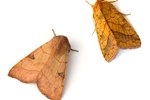
Seahorse males do something highly unusual in the animal kingdom; they get pregnant and deliver their offspring. Scientists don't have a clear reason why seahorses evolved this way, but they theorize this is one of the ways seahorses try to help the species survive. Neither parent gets involved in the child-rearing, though. When the male delivers the babies, they are on their own.
How It Works
Although the male carries the eggs, he doesn't make them. After a male and female seahorse spend time courting, the female deposits her eggs inside the male's pouch. He fertilizes the eggs inside the pouch. His pouch is a complex organ that regulates temperature, blood flow and water salinity for the eggs as they hatch so the babies are as prepared as possible for life in the ocean.
Making More Babies
One theory about why male seahorses carry the babies is that this gives the species the ability to create more babies quickly. The female deposits all her available eggs into his pouch when they mate, so she needs time to make more eggs. While he's carrying one set of eggs, she's creating more so they are ready when the first group is born. The male can deliver babies in the morning and get pregnant again the same day. The female expends her energy making more eggs rather than carrying fertilized ones.
Sharing the Load
Creating new life takes a lot of energy, which factors into another theory as to why male seahorses carry the babies. When the females create the eggs, she uses her energy to fill the egg casings with nutrients to help the babies mature. This takes some of the stress off the dad. He provides a safe and environmentally controlled environment for his babies, but the mom gives them some food.
Problems
Depending on the species, seahorses can deliver from five to more than 1,000 babies at a time. Unfortunately, only about five out of every thousand survive to adulthood. The babies are so tiny that they can't eat the same plankton food as their parents, so their choices are limited. Also, they tend to get carried away by ocean currents before they can latch onto rocks or other secure objects with their tails, becoming part of the zooplankton other animals eat. The fact that so few survive might be the reason seahorses share the baby duties more than other creatures.
References
Photo Credits
-
Medioimages/Photodisc/Photodisc/Getty Images




